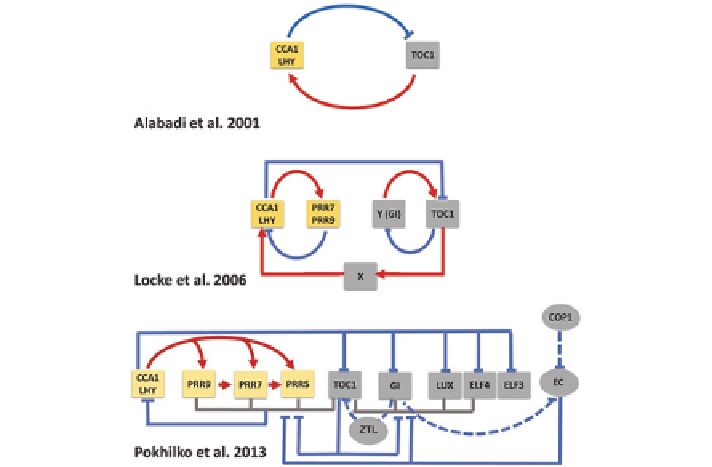Agriculture Reference
In-Depth Information
Fig. 19.2
Historical evolution of the proposed model of the
Arabidopsis
circadian clock. Schematic
representation of the three most relevant models (Alabadi et al.
2001
; Locke et al.
2006
; Pokhilko
et al.
2013
) proposed for the
Arabidopsis
circadian clock core regulation.
Red arrows
and
blue bro-
ken lines
represent activation and repression, respectively. Elements belonging to the morning or
evening loop are shown in
yellow
and
gray
, respectively. For simplicity, only elements in circles
represent proteins (EC, ZTL and COP1). Post-translational regulation is indicated by
dotted lines
arrhythmia (Más et al.
2003a
). In contrast,
TOC1
loss-of-function mutant showed
a clear period shortening under white light conditions (Más et al.
2003a
) and com-
plete arrhythmia under constant darkness or red light. Therefore, TOC1 shows a
dual function dependent and independent of light, suggesting a possible role as
molecular connector between the clock input and the processes rhythmically con-
trolled by the oscillator (Más et al.
2003a
).
After the initially described feedback loop between
TOC1
and
CCA1
/
LHY
,
early computational models postulated the presence of at least two additional
feedback loops interconnected between them (Locke et al.
2006
; Rand et al.
2004
; Zeilinger et al.
2006
). In the so-called morning loop, CCA1/LHY activates
the expression of
PSEUDO RESPONSE REGULATOR 7
(
PRR7
) and
PSEUDO
RESPONSE REGULATOR 9
(
PRR9
), both members of TOC1 family. In turn,
PRR7 and PRR9 act to repress the expression of
CCA1
/
LHY
(Farre et al.
2005
;
Nakamichi et al.
2005
; Salome and McClung
2005
). The evening loop involved
an unknown factor called “Y” that activates
TOC1
expression, whereas TOC1
feeds back by repressing Y expression. The authors proposed
GIGANTEA
(
GI
),
a multiple-domain protein with several independent functions, as a possible fac-
tor “Y”, although genetic data were not entirely consistent with it (Ito et al.
2009
; Martin-Tryon et al.
2007
). Additionally, they suggested the presence of a

Search WWH ::

Custom Search